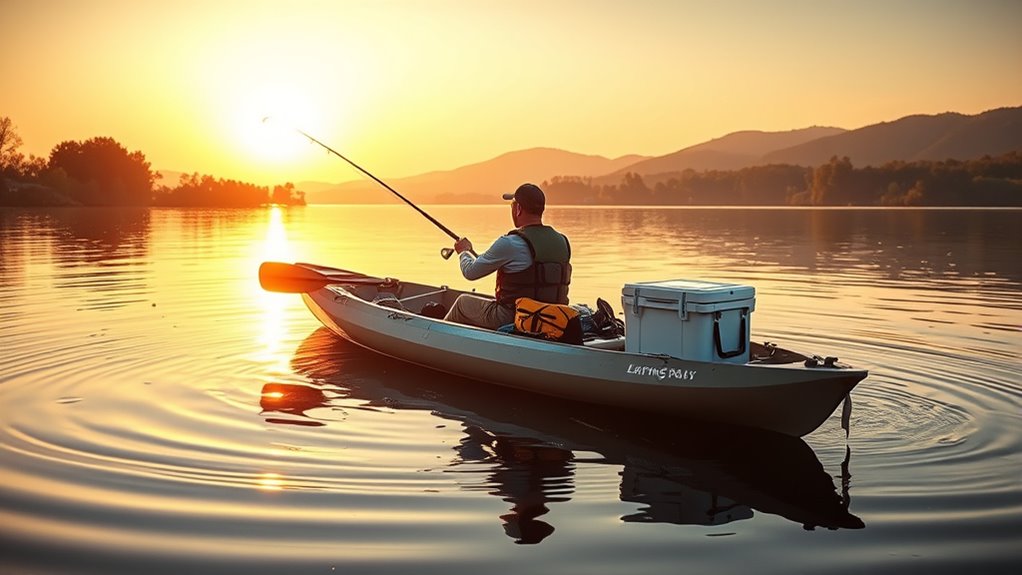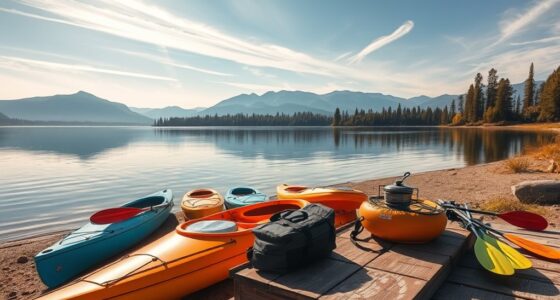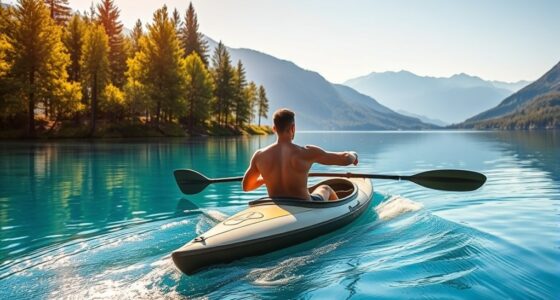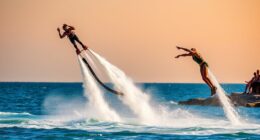Kayak fishing is all about blending excitement with responsibility. You’ll need lightweight gear for stability, along with a comfy seat and essential fishing tools. Always wear your PFD and know your waterway hazards. Use gentle paddling techniques to protect the environment and respect fishing regulations. Keep noise levels low to avoid disturbing wildlife. When done right, kayak fishing is sustainable and rewarding. There’s plenty more to explore about gear choices and best practices ahead!
Key Takeaways
- Choose lightweight and stable gear, including a comfortable seat, fishing rods, and a dry bag to protect valuables from water.
- Familiarize yourself with local waterways, including potential hazards and regulations, to ensure a safe fishing experience.
- Practice ethical fishing by respecting size and bag limits, and managing waste responsibly to protect the environment.
- Use gentle paddling techniques and maintain low noise levels to minimize disturbance to fish and wildlife habitats.
- Always wear a personal flotation device (PFD) and monitor weather conditions to prioritize safety while kayak fishing.
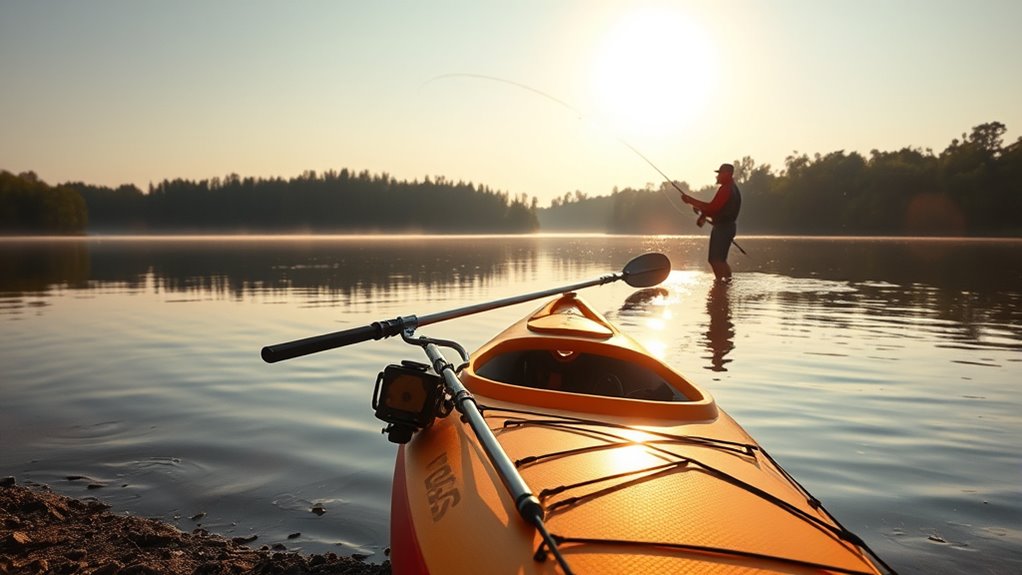
Have you ever wondered how to combine the thrill of fishing with the adventure of kayaking? If you’re eager to try kayak fishing, you’re in for an exhilarating experience. However, before you paddle away, it’s crucial to understand some basics to ensure you have a safe and responsible outing on the water.
First off, kayak safety should be your top priority. Always wear a personal flotation device (PFD) while out on the water. It’s not just a good idea; it’s often required by law. Make sure your kayak is in good condition, with no leaks or damage. Familiarize yourself with the local waterways, paying attention to potential hazards like strong currents, low bridges, or busy boat traffic. Before you launch, check the weather; conditions can change quickly, and being prepared can make all the difference in your safety.
Prioritize kayak safety: wear a PFD, check your gear, and stay informed about local waterways and weather conditions.
Equipping your kayak for fishing also requires careful consideration. You’ll want to pack lightweight gear that won’t compromise your kayak’s stability. A comfortable seat, fishing rods, and tackle boxes are essential, but remember to leave enough space for yourself to maneuver safely. It’s wise to bring a dry bag for your valuables, ensuring they stay dry while you focus on fishing. Also, consider a leash for your fishing rod; losing your gear to the water can be frustrating and dangerous. Additionally, you may want to consider suspension upgrades for your kayak to improve stability while casting and reeling in fish.
While you’re out there enjoying the natural beauty, don’t forget your commitment to environmental responsibility. Always follow the Leave No Trace principles. This means packing out what you pack in, including any fishing line, plastic, or other waste. Fish responsibly by adhering to local regulations, such as size and bag limits. Not only does this help preserve fish populations, but it also guarantees future generations can enjoy the same experiences you cherish.
Finally, respect the aquatic environment around you. Stay clear of nesting areas, and avoid disturbing wildlife. Be mindful of your paddling technique to minimize your impact on the water. It’s essential to keep your noise levels down and avoid sudden movements that could scare away fish or wildlife.
Kayak fishing can be a rewarding blend of adventure and relaxation, but it’s vital to prioritize safety and environmental stewardship. By following these guidelines, you can enjoy the thrill of fishing while ensuring a safe and responsible experience on the water. So grab your gear, hit the water, and embrace the adventure that awaits!
Frequently Asked Questions
What Types of Fish Are Best for Kayak Fishing?
When you’re kayak fishing, species targeting is essential for success. Popular choices include bass, trout, and catfish, as they’re often found in shallow waters where you can easily navigate. For bait selection, live bait like minnows or worms works wonders, but don’t underestimate lures that mimic their natural prey. Pay attention to local regulations and seasonal patterns to maximize your catch while enjoying the unique experience kayak fishing offers.
How Do I Choose the Right Kayak for Fishing?
How do you pick the perfect kayak for fishing? Start by considering your storage needs and the type of water you’ll fish in. Sit-on-top kayaks offer great stability and easy access to gear, while sit-ins provide protection from the elements. Don’t forget about kayak accessories like rod holders and coolers that can enhance your experience. Choose a kayak that fits your style and guarantees a comfortable, enjoyable day on the water!
Can I Use My Regular Fishing Gear for Kayak Fishing?
Yes, you can definitely use your regular fishing gear for kayak fishing! Just make sure it fits well in your kayak storage. When you’re paddling, keep your gear secure to avoid any accidents while steering. Familiarize yourself with kayak paddling techniques to maintain balance and stability. This way, you’ll enjoy a smooth fishing experience and successfully reel in your catch without hassle. Happy fishing!
What Safety Equipment Should I Carry While Kayak Fishing?
You should always carry a personal flotation device (PFD), a whistle, and a first-aid kit while kayak fishing. It’s a coincidence that these items fit neatly in your kayak storage! Additionally, bring a waterproof dry bag for your essentials. Don’t forget to check the weather beforehand; sudden changes can catch you off guard. Being prepared keeps your adventure safe and enjoyable, so gear up with the right safety equipment!
Are There Specific Fishing Regulations for Kayak Anglers?
Yes, there are specific fishing regulations for kayak anglers. You’ll need to check the fishing license requirements in your state, as they can vary greatly. Additionally, be aware of protected species regulations, which prohibit the capture of certain fish. Always keep up-to-date with local guidelines to guarantee you’re fishing legally and responsibly. Ignoring these rules can lead to fines and harm to the environment, so it’s essential to stay informed.
Conclusion
As you paddle through the waters of your fishing journey, remember that each cast is a step on a path woven with respect and responsibility. Just as a wise fisherman knows the rhythm of the tides, you too must learn the harmony of nature’s ways. Equip yourself not only with gear but with the ethics of stewardship. In this delicate dance between angler and environment, may you find joy, honor, and the thrill of the catch.

